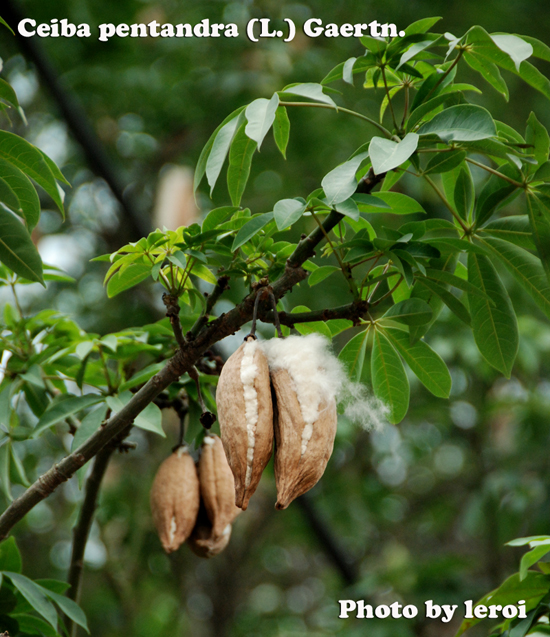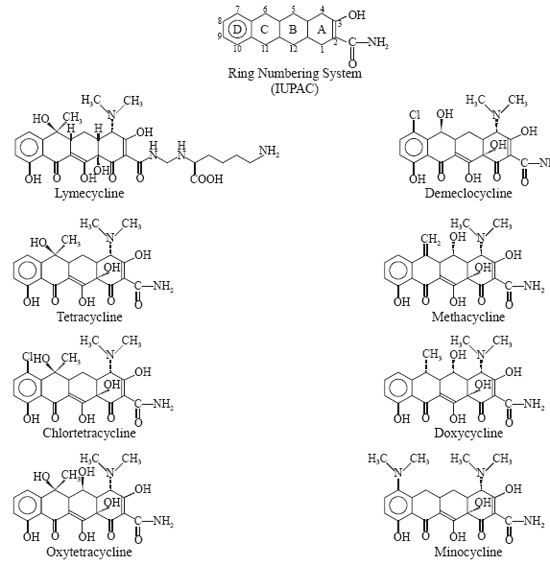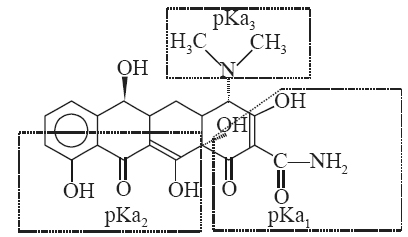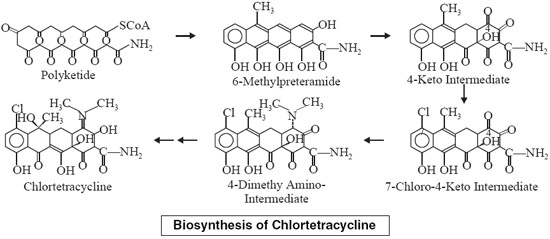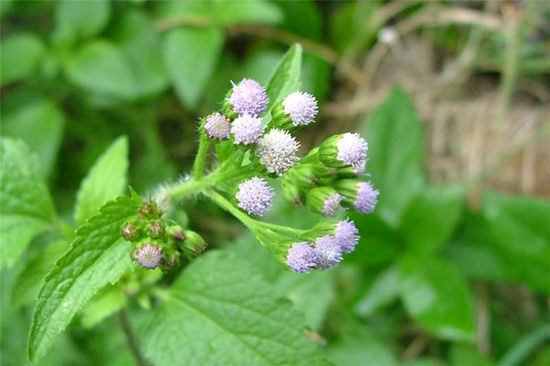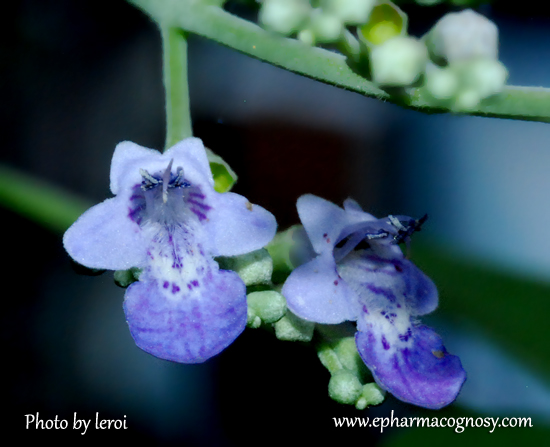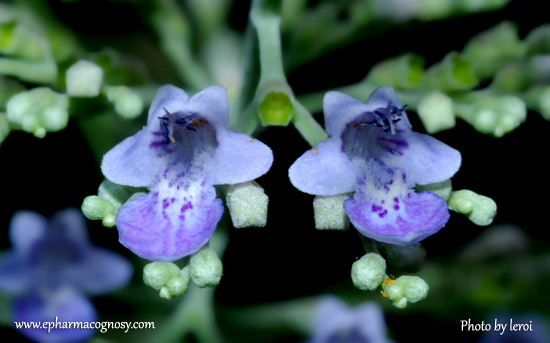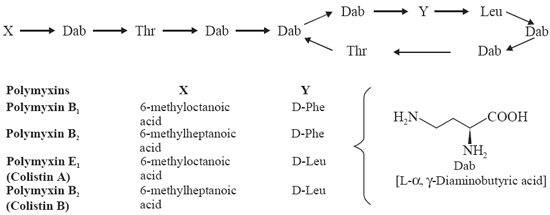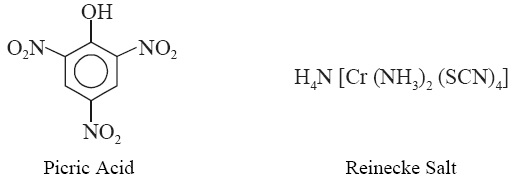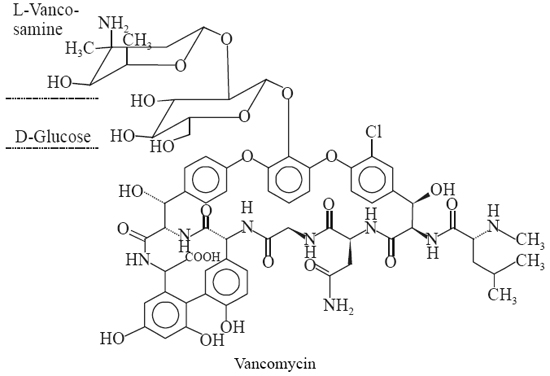The tetracyclines are a conglomerate of broad spectrum orally active actinomycete antibiotics produced by cultures of Streptomyces species, and possessing appreciable therapeutic value. Chlortetracycline was the first bonafide member of this group isolated from Streptomycesaureofaciens and discovered by Duggar in 1948. It was immediately followed by oxytetracycline in 1950 from the cultures of Streptomyces rimosus; and in 1953 tetracycline was eventually discovered in the antibiotic mixture from S. aureofaciens as a minor antibiotic.
Consequently, the intensive and extensive research and development in the selection of mutant strains, and specifically in the manipulations and manifestations to monitor and control both ‘methylation’ and ‘chlorination’ procedures have resulted in the fermentative production of a good number of tetracycline variants, namely: demeclocycline, methacycline, doxycycline, minocycline, lymecycline as given below:
These compounds shall now be discussed individually as under:
3.9.1 Tetracycline
Synonyms Deschlorobiomycin; Tsiklomitsin; Abricycline; Ambramycin; Bio-Tetra; Cyclomycin; Dumocyclin; Tetradecin;
Biological Source It is obtained from a Streptomyces species cultured in an appropriate nutrient medium.
Preparation It may be prepared by removal of chlorine from chlortetracycline and subjecting it to hydrogenation.
Chemical Structure Please see Section 3.9.
Characteristic Features
1. It is obtained as a yellow crystalline powder; odourless, and stable in air.
2. It usually darkens on exposure to strong sunlight.
3. Its potency is seriously affected in solutions of pH < 2.
4. It is destroyed rapidly by alkali hydroxide solutions.
5. It is found to be more soluble than chlortetracycline.
6. It is rather more stable within the physiological and moderately alkaline spectrum of pH.
7. The solutions of tetracycline gets darkened more rapidly than chlortetracycline but less than oxytetracycline.
8. The pH of an aqueous suspension (1 mg . mL–1) ranges between 3.0 to 7.0.
9. Its dissociation constant pKa are: 3.3; 7.7; 7.9.
10. Solubility Profile: 1g is soluble in ~ 2500 mL water; ~ 50 mL ethanol; freely soluble in dilute HCl or alkali hydroxide solutions; and almost insoluble in ether or chloroform.
Uses
1. It is found to be useful in the treatment of toxoplasmosis.
2. The GI side effects are comparatively less than those from chlortetracycline and oxytetracycline but more than from demeclocycline.
3. The plasma half-life ranges between 6 to 11 hours in patients with normal renal function. Tetracycline Hydrochloride [C22H24N2O8.HCl] [Synonyms Achro; Achromycin; Ala Tet; Ambracyn; Ambramicina; Bristaciclina; Cefracycline; Cyclopar; Diocyclin; Hostacyclin;Mephacyclin; Panmycin; Polycycline; Quadracycln; Remicyclin; Sanclomycine; Supramycin; Tetramycin; Topicycline; Totomycin; Unicin.
Characteristic Features
1. The crystals of tetracycline hydrochloride are obtained from butanol + HCl which decomposes at 214°C.
2. Its specific optical rotation [α]D25-257.9° (C = 0.5 in 0.1 N HCl).
3. It is freely soluble in water; soluble in methanol, ethanol; and insoluble in ether and hydrocarbons.
4. The pH of a 2% (w/v) aqueous solution ranges between 2.1-2.3.
3.9.2 Chlortetracycline
Synonyms 7-Chlorotetracycline; Acronize; Aureocina; Aureomycin; Biomitsin; Centraureo; Chrysomykine; Orospray.
Biological Source It is obtained from the substrate of Streptomyces aureofaciens.
Chemical Structure Please refer to Section 9.3.9.
Characteristic Features
1. It is obtained as golden-yellow crystals having mp 168-169°C.
2. It has specific optical rotation [α]D23-275.0° (methanol).
3. It has uvmax (0.1 N HCl): 230, 262.5, 267.5 nm, and (0.1N NaOH): 255, 285, 345 nm.
4. Its solubility in water ranges between 0.5-0.6 mg mL–1, very soluble in aqueous solutions above pH 8.5; freely soluble in the cellosolves, dioxane and carbitol; slightly soluble in methanol, ethanol, butanol, acetone, benzene, ethyl acetate; and almost insoluble in ether and petroleum ether.
Uses
1. It exerts antiamebic activity.
2. It is the first tetracycline antibiotic available for topical application, including ophthalmic purposes.
3. Though its general use has been replaced by other tetracycline antibiotics in human beings, but it is still employed in veterinary medicine.
3.9.3 Oxytetracycline
Synonyms Glomycin; Riomistin; Hydroxytetracycline.
Biological Sources It is an antibiotic substance obtained from the elaboration products of the actinomycete, Streptomyces rimosus, grown on a suitable medium. Oxytetracycline may also be obtained from Streptomyces xanthophaeus.
Chemical Structure Refert to Section 3.9.
Characteristic Features
1. It is obtained as pale yellow to tan, odourless, crystalline powder.
2. It is fairly stable in air, but an exposure to strong sunlight gets darkened.
3. Like tetracycline it also gets deteriorated in solution of pH less than 2, and is quickly destroyed by alkali hydroxide solutions.
4. Its saturated solution is almost neutral to litmus and shows a pH ~ 6.5.
5. Solubility Profile: 1g in 4150 mL water; 100 ml ethanol; > 10,000 ml chloroform; 6250 mL ether; and freely soluble in diluted HCl or alkaline solutions.
6. Stability: Its crystals exhibit no loss in potency on heating for a duration of 4 days at 100°C; whereas the hydrochloride crystals show < 5% inactivation after 4 months at 56°C. It has been observed that the aqueous solutions of the hydrochloride at pH 1.0 to 2.5 are quite stable for at least 30 days at 25°C. It has been observed that the aqueous solutions of the hydrochloride at pH 1.0 to 2.5 are quite stable for at least 30 days at 25°C. However, its solutions at pH 3.0 to 9.0 show no detectable loss in potency on storage at + 5°C for at least 30 days. Half life in hours at aqueous oxytetracycline solutions at 37°C: pH 1.0 = 114; pH 2.5 = 134; pH 4.6 = 45; pH 5.5 = 45; pH 7.0 = 26; pH 8.5 = 33; and pH 10.0 = 14.
Oxytetracycline Hydrochloride [C22H24N2O9.HCl] [Synonyms Alamycin, Duphacycline; Engemycin; Geomycin; Oxlopar; Oxybiocycline; Oxycyclin Oxy-Dumocyclin; Oxytetracid; Oxytetrin; Tetran; Vendarcin]
It is obtained as yellow platelets from water and is found to be extremely soluble in water (1g/mL). It is also soluble in absolute ethanol: 12,000 g/mL; and in 95% (v/v) ethanol: 33,000 g/mL.
Note: Its concentrated aqueous solutions at neutral pH hydrolyze on standing and consequently deposit crystals of oxytetracycline. Oxytetracycline Dihydrate [C22H24N2O9.2H2O] [Synonyms Abbocin; Clinimycin; Oxymycin; Stevacin; Terramycin; Unimycin]
It is obtained as needles from water or methanol which decompose at 181-182°C. Its specific optical rotations are: [α]D25-2.1° (0.1N NaOH); and [α]D25-196.6 (0.1N HCl). It has uvmax (pH 4.5 phosphate buffer 0.1 M): 249, 276, 353 nm (E1%1cm 240, 322, 301). It is found to be soluble in water at 23°C at various pH's: pH 1.2 = 31, 400 g/mL; pH 2.0 = 4600 γ/mL; pH 3.0 = 1400 γ/mL; and pH 9.0 = 38,600 γ/mL. It is soluble in absolute ethanol 12,000 γ/mL and in 95% (v/v) ethanol 200 g/mL.
3.9.4 Demeclocycline
Synonyms Bioterciclin; Declomycin; Deganol; Ledermycin; Periciclina; Demethylchlortetracycline (obsolete).
Biological Source Demeclocycline is related to tetracycline and produced by Streptomyces aureofaciens.
Preparation A suitable strain of S. aureofaciens is grown in an appropriate liquid nutrient medium under controlled experimental parameters of pH, temperature, and extent of aeration. Subsequently, the duly harvested broth is acidified carefully and filtered. The demeclocycline is isolated from the resulting filtrate, either by solvent extraction or by chemical precipitation.
Chemical Structure Refer to section 3.9.
Characteristic Features
Demeclocycline Hydrochloride [C21H21ClN2O8.HCl] [Synonyms: Clortetrin; Demetraciclina; Detravis; Meciclin; Mexocine]
1. It is obtained as yellow, crystalline powder, odourless and having a bitter taste.
2. The pH of 1 in 100 solution is ~ 2.5.
3. It essentially has three distinct dissociation constants, namely: pKa1, 2, 3: 3.3, 7.2, 9.3 attributed by three separate zones in its complex molecule as shown below:
4. Solubility Profile: 1g soluble in ~ 60 mL water; 200 mL ethanol or 50 mL methanol; sparingly soluble in alkali hydroxides or carbonates; and almost insoluble in chloroform.
Uses
1. It is an intermediate-acting tetracycline and causes comparatively a greater extent of phytotoxicity than other members of its class.
2. Its better absorption and slower exeretion by the body render blood levels that distinctly afford certain minor therapeutic advantages than other members of its class.
Demeclocycline Sesquihydrate It has mp 174-178°C (decomposes); and specific optical rotation [α]25D-258° (C = 0.5 in 0.1 N H2SO4).
3.9.5 Methacycline
Synonyms Metacycline, Bialatan; 6-Methylene-5-hydroxytetracycline.
Biological Source It is broad spectrum, semi-synthetic antibiotic related to tetracycline, which is obtained from Streptomyces rimosus.
Preparation It may be prepared by a chemical dehydration reaction from oxytetracycline; besides, it has a methylene function at C-6 position.
Chemical Structure Please refer to Section 3.9.
Characteristic Features
Methacycline Hydrochloride [C22H22N2O8.HCl] [Synonyms Adriamicina; Ciclobiotic;
Germiciclin; Metadomns; Metilenbiotic; Londomycin; Optimycin; Physiomycine; Rindex; Rondomycin]:
1. It is invariably obtained as crystals containing 0.5 mole water and 0.5 mole methanol; and also from a mixture of methanol + acetone + concentrated HCl + ether. It is a yellow crystalline
powder which decompose at ~ 205°C and has a bitter taste.
2. It has uvmax (methanol + 0.1 N HCl): 253, 345 nm (log e 4.37, 4.19).
3. It is found to be soluble in water; sparingly soluble in ethanol; and practically insoluble in chloroform and ether.
Uses
1. The utility of methacycline is particularly associated with good oral absorption.
2. It has a prolonged serum half-life.
3.9.6 Doxycycline
Synonyms Jenacylin; Supracyclin; Vibramycin.
Preparation Methacycline (i.e., 6-deoxy-6-demethyl-6-methylene-5-oxytetracycline) is either dissolved or suspended usually in an inert organic solvent, for instance: methanol and subjected to hydrogenation under the influence of catalytic quantities of noble metals, namely: Rhodium or Palladium to yield a mixture of the 6α-and 6β-methyl epimers. The desired epimer i.e., α-6-deoxy-5-hydroxytetracycline, is subsequently isolated by specific chromatographic methods (US Pat 3,200,149).
Chemical Structure Refer to Section 3.9.
Characteristic Features
Doxycycline Hydrochloride Hemiethanolate Hemihydrate [C22H25Cl N2O8.1/2C2H60.1/2H2O]
[Synonyms Doxycycline hyclate; Azudoxat; Diocimex; Doxatet; Doxychel hyclate; Duradoxal; Hydramycin; Paldomycin; Sigadoxin; Tetradox; Unacil; Vibramycin hyclate; Vibra-Tabs; Zadorin]:
1. It is obtained as light yellow, crystalline powder from ethanol + HCl; and gets charred without melting at ~ 201°C.
2. It has specific optical rotation [α]25D-110°C (C = 1 in 0.01 N methanolic HCl).
3. It has uvmax (0.01N methanolic HCl): 267, 351 nm (log ε 4.24, 4.12).
4. It is found to be soluble in water.
5. Both the inherant ethanol and water of crystallization (1/2 mol of each) are usually lost by subject to drying at 100°C under reduced pressure.
6. Its dissociation constant has three values, namely: pKa 3.4, 7.7, and 9.7 (see demeclocycline).
7. Solubility Profile: It is very slightly soluble in water; freely soluble in dilute acid or alkali hydroxide solution; sparingly soluble in ethanol; and practically insoluble in ether or chloroform.
Uses
1. The 6α-isomer of doxycycline is found to be more active biologically than the corresponding 6β-epimer hydrochloride.
2. It is active against Gram-positive organisms wherein it is almost
twice as potent as
tetracycline; and having an exception that it is virtually 10 times as potent against
Streptomyces viridans.3. Interestingly, strains of Enterococcus fecalis that are observed to be more resistant to other tetracyclines may prove to be sensitive to this drug.
4. Against Gram-negative organisms it is found to be twice as potent as tetracycline.
5. It is considered to be the drug of first choice for the prophylaxis of traveler’s diarrhea, commonly caused by enterotoxigenic E. coli.
6. It is found to be the best amongst the ‘tetracyclines’ against anaerobes.
7. It is absorbed almost completely i.e., 90 to 100% through oral administration than the rest of tetracyclines, and its absorption does not seem to be retarded by intake of foods.
8. Its plasma-protein binding is almost 93%.
9. Its volume of distribution stands at 0.75 mL g–1.
10. It is found to penetrate rapidly body fluids, cavities and cells.
11. It is invariably eliminated upto 65% through hepatic metabolism, and the balance 35% through biliary/renal exertion.
12. The rate of exertion is rather slow and the half-life is the longest among the ‘tetracyclines’, namely, 12 to 22 hr.
Note: 1. Photosensitization usually takes place more frequently as compared to other shorteracting tetracyclines.
2. Complexation with Ca2+ is to a lesser extent than other tetracyclines; besides, it is not affected by either dairy products or foods.
3.9.7 Minocycline
Synonyms Minocyn.
Biological Source It is a semi-synthetic antibiotic obtained from 6-demethyl tetracycline.
Preparation 6-Demethyl tetracycline is first dissolved in tetrahydrofuran (solvent) containing aliquot quantity of methanesulphonic acid, and is subsequently reacted with dibenzyl azodicarboxylate to form 7-[1, 2-bis (carbobenzoxy) hydrazino]-6-demethyl-tetracycline. The resulting-product is subjected to Pd-catalyzed hydrogenation in the presence of formaldehyde to yield the desired product minocycline.
Chemical Structure Refer to section 3.9.
Characteristic Features
1. It is obtained as bright yellow-orange amorphous solid.
2. Its specific optical rotation [α]25D-116° (C = 0.524).
3. It has uvmax (0.1N HCl): 352, 263nm (log ε 4.16, 4.23); (01 N NaOH) : 380, 243 nm (log ε 4.30; 4.38).
Uses
1. It is readily absorbed from the intestinal tract.
2. It has a slow renal clearance to afford prolonged blood levels; and is normally characterized by relatively lower MICs as compared to other tetracycline antibiotics for certain pathogenic organisms.
Minocycline Hydrochloride [C23H27N2O7.HCl] [Synonyms Klinomycin Minomycin; Veetrin]
Characteristic Features
1. It is obtained as yellow, crystalline powder, odourless, slightly bitter taste and slightly hygroscopic in nature.
2. It is fairly stable in air when protected from light and moisture; however, strong uv-light and/or moist air causes it to darken rather rapidly.
3. Its potency* in solution is primarily affected on account of epimerization.
4. The pH of 1 in 100 solution ranges between 3.5 to 4.5.
5. It distinctly gives rise to four dissociation constant values, namely: pKa12.8; pKa2 5; pKa3 7.8; and pKa4 9.3; mainly due to an additional dimethylamino moiety at e-7 position (compare with demeclocycline, Section 9.4).
--------------------------------------------------------
* Potency: It is equivalent to not less than 785 mcg of minocycline mg–1.
6. Solubility Profile: 1 g in nearly 60 mL water and ~ 70 mL alcohol; soluble in solutions of alkali hydroxides or carbonates; and almost insoluble in chloroform and ether.
Uses
1. Generally, it is found to be 2-4 times as potent as tetracycline against majority of Gram-positive bacteria.
2. It is found to exhibit an equally low-potency against Enterococcus fecalis.
3. It is almost 8 times as potent as tetracycline against Streptococcus viridans.
4. It is 2 to 4 times as potent as tetracycline against Gram-negative organisms.
5. It is now the drug of choice for treating infections caused by Mycobacterium marinum.
Note: It particularly differs from other tetracyclines wherein the bacterial resistance to the drug is not only of low incidence but also of a lower order; which is especially true to staphylococci, in which cross-resistance is observed to be as low as 4%.
6. It is absorbed by the oral route to the extent of 90-100%.
7. Diminution in absorption is caused exclusively by food and milk and substantially by iron preparations and nonsystemic antacids.
8. It is normally protein-bound in plasma between 70-75%.
9. Its ‘volume of distribution’* ranges between 0.14 to 0.7 mLg–1.
10. Its half-life varies between 11 to 17 hours.
3.9.8 Lymecycline
Synonyms Armyl; Ciclolysol; Mucomycin; Tetralisal; Tetramyl; Tetralysal; N-Lysinomethyl tetracycline.
Biological Source It is a semi-synthetic antibiotic related to tetracycline. It is a classic example of an antibiotic developed by qualified chemical modification of the primary amide function at C-2.
Preparation It may be prepared by the method suggested by Tubaro and Raffaldoni.**
Chemical Structure Refer to Section 3.9.
Characteristic Features
Lymecycline Sodium [C29H37N4NaO10]: It has uvmax (CH3OH): 376 nm. It is used as a potent antibacterial agent.
3.9.9 Biosynthesis of Chlortetracycline
The various steps involved in the biosynthesis of chlortetracycline are as stated below:
1. A malonamyl-CoA residue probably caters for as a ‘primer’; and eight such malonate entities undergo stepwise condensations with the addition of C2units and followed by decarboxylation to yield a linear C19 polyketide.
2. Subsequently, the carbonyl-methylene condensations give rise to the tetracyclic pretetramide nucleus.
--------------------------------------------------------
* Volume of Distribution It is pharmacokinetic parameter representing a proportionality constant that relates drug
concentration in a reference fluid, typically plasma, to the amount of drug distributed throughout the body.
** Tubaro and Raffaldoni, Bull. Chim. Farm., 100, 9 (1961).
3. Importantly, methylation at the C-6 position of the pretetramide is normally regarded an initial step in the biosynthesis of most tetracyclines; however, this particular step is usually left out in the creation of the naturally occurring dimethyl tetracyclines.
4. Hydroxylation at the C-4 position followed by dearomatization to produce a 4-keto intermediate appears to precede 7-chlorination.
5. It is necessary that halogenation should precede introduction of the 4-amino group, which is methylated in a stepwise manner.
6. Terminal reactions in the biosynthetic sequence are carried out in two stages: first, hydroxylation at C-6 position; and secondly, reduction of double bond in ring B.
7. It is, however, interesting to absence that the presence of a 7-halogen substituent evidently blocks 5-hydroxylation.
The various steps involved in the
biosynthesis of chlortetracycline may be summarized as given below:

